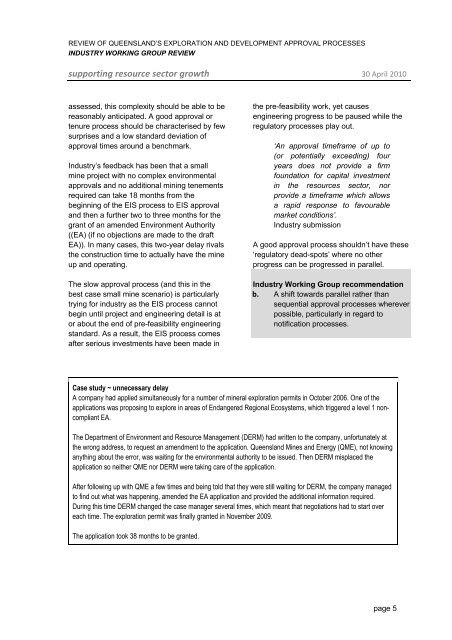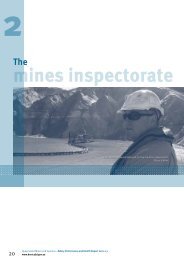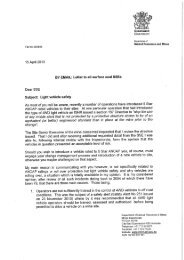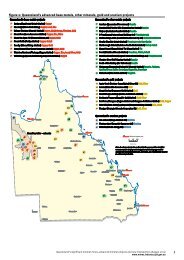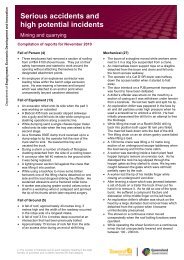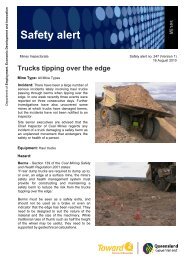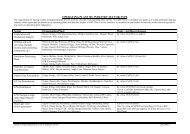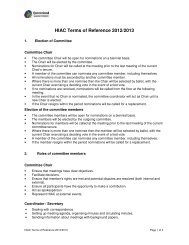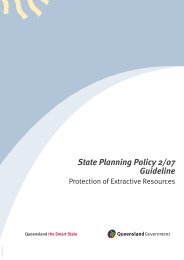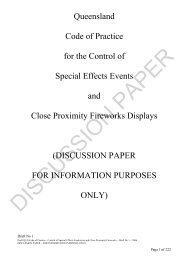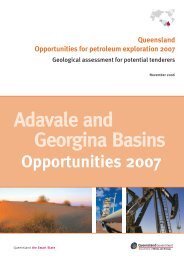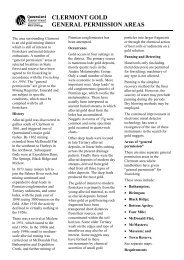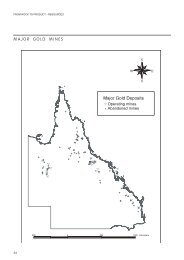supporting resource sector growth - Queensland Mining and Safety ...
supporting resource sector growth - Queensland Mining and Safety ...
supporting resource sector growth - Queensland Mining and Safety ...
Create successful ePaper yourself
Turn your PDF publications into a flip-book with our unique Google optimized e-Paper software.
REVIEW OF QUEENSLAND’S EXPLORATION AND DEVELOPMENT APPROVAL PROCESSES<br />
INDUSTRY WORKING GROUP REVIEW<br />
<strong>supporting</strong> <strong>resource</strong> <strong>sector</strong> <strong>growth</strong> 30 April 2010<br />
assessed, this complexity should be able to be<br />
reasonably anticipated. A good approval or<br />
tenure process should be characterised by few<br />
surprises <strong>and</strong> a low st<strong>and</strong>ard deviation of<br />
approval times around a benchmark.<br />
Industry’s feedback has been that a small<br />
mine project with no complex environmental<br />
approvals <strong>and</strong> no additional mining tenements<br />
required can take 18 months from the<br />
beginning of the EIS process to EIS approval<br />
<strong>and</strong> then a further two to three months for the<br />
grant of an amended Environment Authority<br />
((EA) (if no objections are made to the draft<br />
EA)). In many cases, this two-year delay rivals<br />
the construction time to actually have the mine<br />
up <strong>and</strong> operating.<br />
The slow approval process (<strong>and</strong> this in the<br />
best case small mine scenario) is particularly<br />
trying for industry as the EIS process cannot<br />
begin until project <strong>and</strong> engineering detail is at<br />
or about the end of pre-feasibility engineering<br />
st<strong>and</strong>ard. As a result, the EIS process comes<br />
after serious investments have been made in<br />
the pre-feasibility work, yet causes<br />
engineering progress to be paused while the<br />
regulatory processes play out.<br />
‘An approval timeframe of up to<br />
(or potentially exceeding) four<br />
years does not provide a firm<br />
foundation for capital investment<br />
in the <strong>resource</strong>s <strong>sector</strong>, nor<br />
provide a timeframe which allows<br />
a rapid response to favourable<br />
market conditions’.<br />
Industry submission<br />
A good approval process shouldn’t have these<br />
‘regulatory dead-spots’ where no other<br />
progress can be progressed in parallel.<br />
Industry Working Group recommendation<br />
b. A shift towards parallel rather than<br />
sequential approval processes wherever<br />
possible, particularly in regard to<br />
notification processes.<br />
Case study ~ unnecessary delay<br />
A company had applied simultaneously for a number of mineral exploration permits in October 2006. One of the<br />
applications was proposing to explore in areas of Endangered Regional Ecosystems, which triggered a level 1 noncompliant<br />
EA.<br />
The Department of Environment <strong>and</strong> Resource Management (DERM) had written to the company, unfortunately at<br />
the wrong address, to request an amendment to the application. <strong>Queensl<strong>and</strong></strong> Mines <strong>and</strong> Energy (QME), not knowing<br />
anything about the error, was waiting for the environmental authority to be issued. Then DERM misplaced the<br />
application so neither QME nor DERM were taking care of the application.<br />
After following up with QME a few times <strong>and</strong> being told that they were still waiting for DERM, the company managed<br />
to find out what was happening, amended the EA application <strong>and</strong> provided the additional information required.<br />
During this time DERM changed the case manager several times, which meant that negotiations had to start over<br />
each time. The exploration permit was finally granted in November 2009.<br />
The application took 38 months to be granted.<br />
page 5


